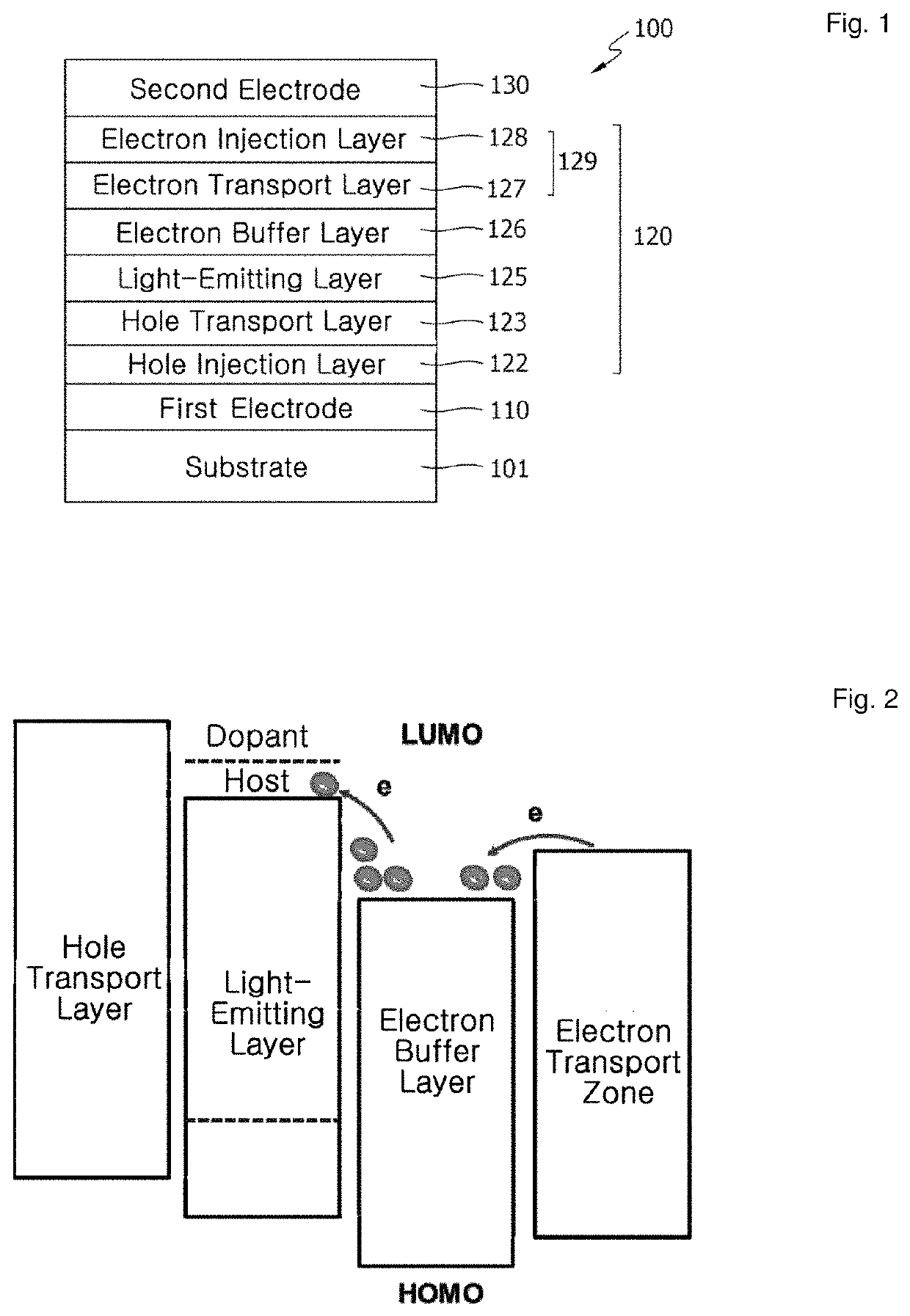Organic electroluminescent compound and organic electroluminescent device comprising the same
a technology of organic electroluminescent devices and electroluminescent compounds, which is applied in the direction of luminescent compositions, organic chemistry, chemistry apparatuses and processes, etc., can solve the problems of reducing affecting the luminous efficiency of current fluorescent light-emitting materials, and affecting the luminous efficiency of current fluorescent materials. , to achieve the effect of improving the luminous efficiency, improving the interface characteristics, and increasing the driving voltag
- Summary
- Abstract
- Description
- Claims
- Application Information
AI Technical Summary
Benefits of technology
Problems solved by technology
Method used
Image
Examples
example 1
on of Compound B-7
[0057]
Preparation of Compound 1-1
[0058]Acetonitrile (60.0 mL) was added to a mixture of tetrachloropyridine (2.17 g, 10.0 mmol, 217.0 g / mol), phenylboronic acid (2.56 g, 21.0 mmol, 122.0 g / mol), K2CO3 (2.76 g, 20.0 mmol, 138.0 g / mol, 2M in deionized water), and tetrakis(triphenylphosphine)palladium(0) (Pd(PPh3)4) (58.0 mg, 0.05 mmol, 1155.0 g / mol) in a two-neck flask under N2 atmosphere, and then the mixture was stirred under reflux for 4 hrs. The reaction results were monitored by using Thin-layer chromatography (TLC). After cooling the mixture to room temperature, white crystals were precipitated from the solution. The crystals were filtered and directly used in a next step.
[0059]1H NMR (400 MHz, CDCl3, ppm): 7.94 (s, 1H), 7.79-7.80 (d, J=6.8 Hz, 4H), 7.42-7.48 (m, 6H). LC-MS-ESI (m / z): C17H11Cl2N calculated 299.03, found (M+H)+ 300.0349.
Preparation of Compound B-7
[0060]Dioxane (150.0 mL) was added to a mixture of compound 1-1 (3.00 g, 10.0 mmol, 300.0 g / mol), co...
example 2
on of Compound B-24
[0062]
Preparation of Compound 2-1
[0063]Acetonitrile (60.0 mL) was added to a mixture of tetrachloropyridine (2.17 g, 10.0 mmol, 217.0 g / mol), naphthalene-2-yl-boronic acid (3.61 g, 21.0 mmol, 172.0 g / mol), K2CO3 (8.70 g, 63.0 mmol, 138.0 g / mol, 2M in deionized water), and Pd(PPh3)4 (58.0 mg, 0.05 mmol, 1155.0 g / mol) in a 250 mL two-neck flask under N2 atmosphere, and then the mixture was stirred under reflux for 4 hrs. The reaction results were monitored by using TLC. After cooling the mixture to room temperature, a lot of white powder was precipitated from the solution. The powder was filtered and recrystallized in alcohol to obtain white powder as a final product.
[0064]1H NMR (400 MHz, CDCl3, ppm): 8.33 (s, 2H), 8.02 (s, 1H), 7.88-7.94 (m, 8H), 7.50-7.56 (m, 4H). LC-MS-ESI (m / z): C25H15Cl2N calculated 399.06, found (M+H)+ 400.0654.
Preparation of Compound B-24
[0065]Dioxane (150.0 mL) was added to a mixture of compound 2-1 (4.00 g, 10.0 mmol, 400.0 g / mol), compoun...
example 3
on of Compound B-56
1-Phenyl-2-(4-(4,4,5,5-tetramethyl-1,3,2-dioxaborolan-2-yl)phenyl)-1H-benz[d]imidazole
[0067]
[0068]A 500 mL four-neck round-bottomed flask (RBF) equipped with an overhead stirrer, a nitrogen inlet, a 125 mL addition funnel, and a thermocouple was purged with anhydrous nitrogen for 10 min. The flask was charged with 2-(4-bromophenyl)-1-phenyl-1H-benzo[d]imidazole (25.0 g, 71.59 mmol) and THF (250.0 mL), and then cooled to −71° C. of internal temperature. 1.6 M n-butyl lithium solution (67.0 mL, 107.2 mmol) in hexane was added dropwise into the flask via an addition funnel for 30 min, and the mixture was further stirred at an internal temperature of −72° C. of for 30 min. 2-isopropoxy-4,4,5,5-tetramethyl-1,3,2-dioxaborolane (32.0 mL, 171.99 mmol) was added to the resulting dark red solution via an addition funnel for 30 min while maintaining the temperature of below −70° C. After removing a cooling bath, the brown slurry was warmed to room temperature and stirred for...
PUM
| Property | Measurement | Unit |
|---|---|---|
| LUMO energy | aaaaa | aaaaa |
| LUMO energy | aaaaa | aaaaa |
| LUMO energy | aaaaa | aaaaa |
Abstract
Description
Claims
Application Information
 Login to View More
Login to View More - R&D
- Intellectual Property
- Life Sciences
- Materials
- Tech Scout
- Unparalleled Data Quality
- Higher Quality Content
- 60% Fewer Hallucinations
Browse by: Latest US Patents, China's latest patents, Technical Efficacy Thesaurus, Application Domain, Technology Topic, Popular Technical Reports.
© 2025 PatSnap. All rights reserved.Legal|Privacy policy|Modern Slavery Act Transparency Statement|Sitemap|About US| Contact US: help@patsnap.com



